There’s been a long-standing relationship between Swift Parrots and a number of different gum trees, for example the Yellow and Greybox in Northern Victoria / Southern NSW and the Blue Gum (Eucalyptus Globulus) here in Tasmania. The globulus produces food that is suitable for Swift Parrots when they’re flowering. And when they flower they flower profusely. So these are preferred areas where there are plenty of foods when the chicks hatch, because the parents leave them and fly away to Victoria and NSW before the chicks. If there is not enough food for the chicks, they don’t survive.
The second thing is the globulus grow to a big size, they produce hollows, so they are great nesting trees. Particularly in our cooler climates – the cooler summers that we have – the conditions are much better here in Tasmania than in Victoria or southern NSW. It is not so much that they prefer to nest in this specific tree – but they need feed and the globulus produces the most feed. But they will occupy hollows in any tree, so you will find them nesting in hollows in stringy-barks, but because most stringybarks on Bruny Island are young – they don’t produce as many hollows. That’s why you tend to see Swift Parrots more in Blue gums. They’ll also go into White Gums, which are the preferred trees of the Forty-Spotted Pardalotes.
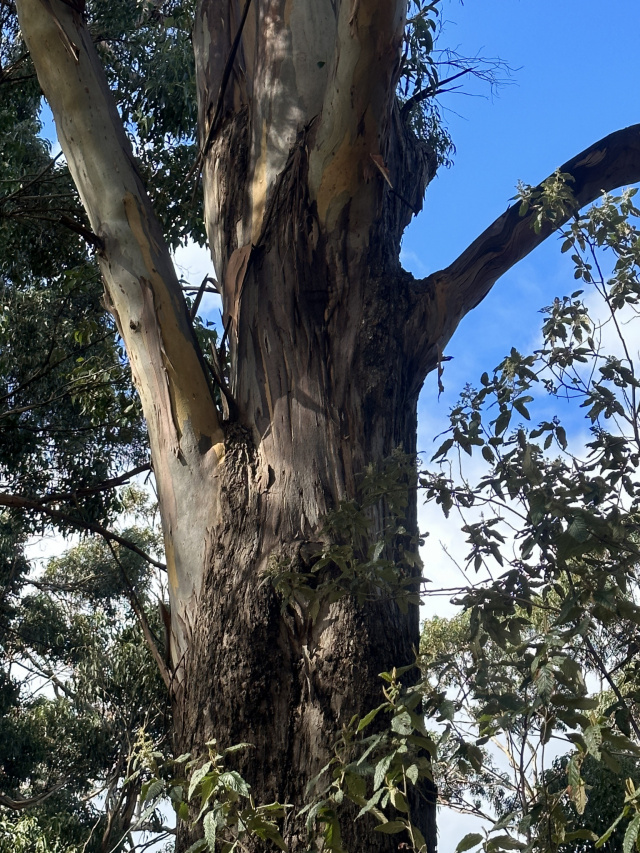
Suitable breeding trees for Swift Parrots are probably even less than that. Because the old eucalypt forests that are left are concentrated in the wetter forests in the South-West, and globulus is not a dominant tree there. So you get these remnant patches.
The other thing is Swift parrot eggs and chicks are prone to predation by particularly Sugar Gliders and small mammals and to displacement by introduced birds such as the Rainbow lorikeet and the myna birds. And Bruny is probably the only place left without a major predator. Swift parrots are in a lot of trouble because we are losing trees right across its range – feeding – breeding – you name it.
On Bruny Island there are many important stands of Blue Gums, such as the along the neck, and in patches along and through the sandstone cliffs on the way to Adventure Bay. For example, the line of magnificent Eucalyptus Globulus trees behind Hanson’s beach get a lot of Swift Parrots.
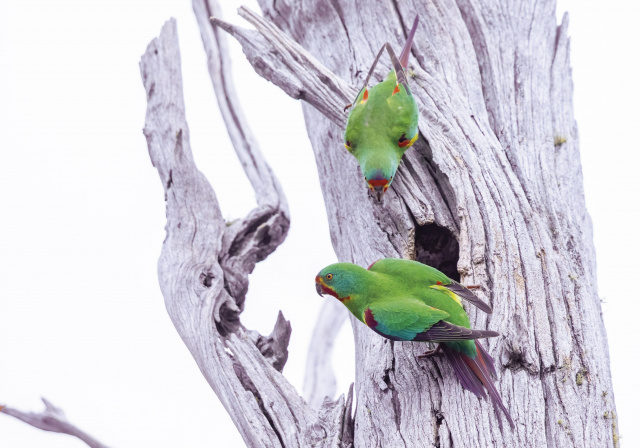
These are the very two trees that feature in the famous painting in the Mitchell Library in Sydney, and that were written about by the botanist Nelson who was with James Cook when he visited here in 1777. He careened his ship right at Resolution Creek by these two trees. They beached the ship and stayed and collected water here.
Professor Jamie Kirkpatrick reckons these trees are about 450 years old. To this day these trees remain really quite important as Swift Parrot trees, and so all of these trees are important to the future of the Swift Parrot.
Cover Image: Swift Parrot in flight, Kim Murray
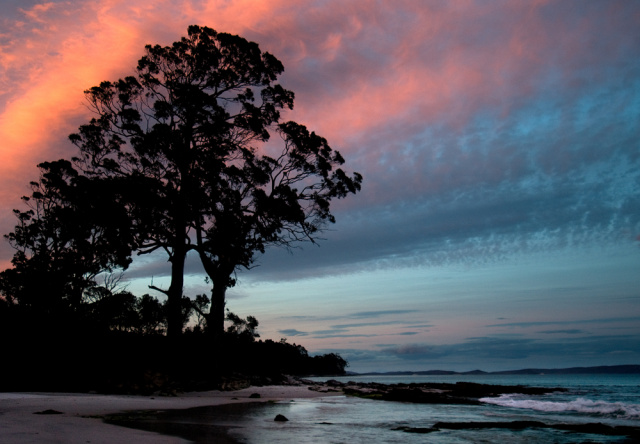
The globulus produces food that is suitable for Swift Parrots when they’re flowering. And when they flower they flower profusely. So these are preferred areas where there are plenty of foods when the chicks hatch
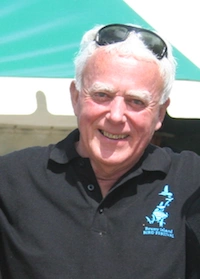
Bob Graham
There’s been a long-standing relationship between Swift Parrots and a number of different gum trees, for example the Yellow and Greybox in Northern Victoria / Southern NSW and the Blue Gum (Eucalyptus Globulus) here in Tasmania. The globulus produces food that is suitable for Swift Parrots when they’re flowering. And when they flower they flower profusely. So these are preferred areas where there are plenty of foods when the chicks hatch, because the parents leave them and fly away to Victoria and NSW before the chicks. If there is not enough food for the chicks, they don’t survive.
The second thing is the globulus grow to a big size, they produce hollows, so they are great nesting trees. Particularly in our cooler climates – the cooler summers that we have – the conditions are much better here in Tasmania than in Victoria or southern NSW. It is not so much that they prefer to nest in this specific tree – but they need feed and the globulus produces the most feed. But they will occupy hollows in any tree, so you will find them nesting in hollows in stringy-barks, but because most stringybarks on Bruny Island are young – they don’t produce as many hollows. That’s why you tend to see Swift Parrots more in Blue gums. They’ll also go into White Gums, which are the preferred trees of the Forty-Spotted Pardalotes.

Suitable breeding trees for Swift Parrots are probably even less than that. Because the old eucalypt forests that are left are concentrated in the wetter forests in the South-West, and globulus is not a dominant tree there. So you get these remnant patches.
The other thing is Swift parrot eggs and chicks are prone to predation by particularly Sugar Gliders and small mammals and to displacement by introduced birds such as the Rainbow lorikeet and the myna birds. And Bruny is probably the only place left without a major predator. Swift parrots are in a lot of trouble because we are losing trees right across its range – feeding – breeding – you name it.
On Bruny Island there are many important stands of Blue Gums, such as the along the neck, and in patches along and through the sandstone cliffs on the way to Adventure Bay. For example, the line of magnificent Eucalyptus Globulus trees behind Hanson’s beach get a lot of Swift Parrots.

These are the very two trees that feature in the famous painting in the Mitchell Library in Sydney, and that were written about by the botanist Nelson who was with James Cook when he visited here in 1777. He careened his ship right at Resolution Creek by these two trees. They beached the ship and stayed and collected water here.
Professor Jamie Kirkpatrick reckons these trees are about 450 years old. To this day these trees remain really quite important as Swift Parrot trees, and so all of these trees are important to the future of the Swift Parrot.
Cover Image: Swift Parrot in flight, Kim Murray

The globulus produces food that is suitable for Swift Parrots when they’re flowering. And when they flower they flower profusely. So these are preferred areas where there are plenty of foods when the chicks hatch
You might like...

Swift parrots and introduced bees compete for nectar

Bruny Island nesting box project
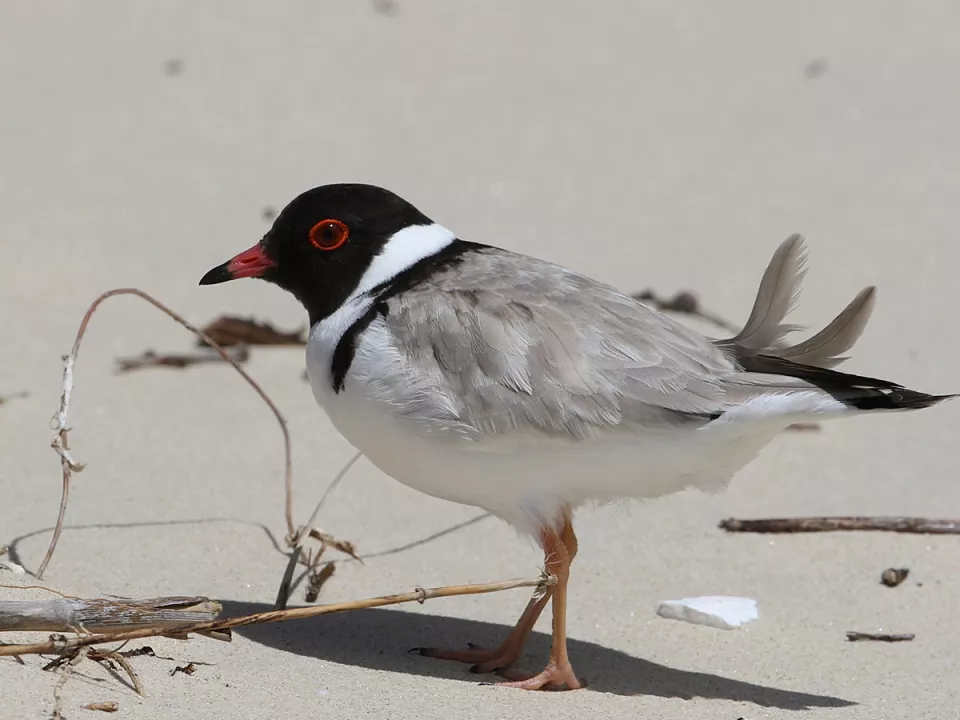
Protecting shorebirds on Bruny Island

Birds playing in wind at the neck
Newsletter
Sign up to keep in touch with articles, updates, events or news from Kuno, your platform for nature
